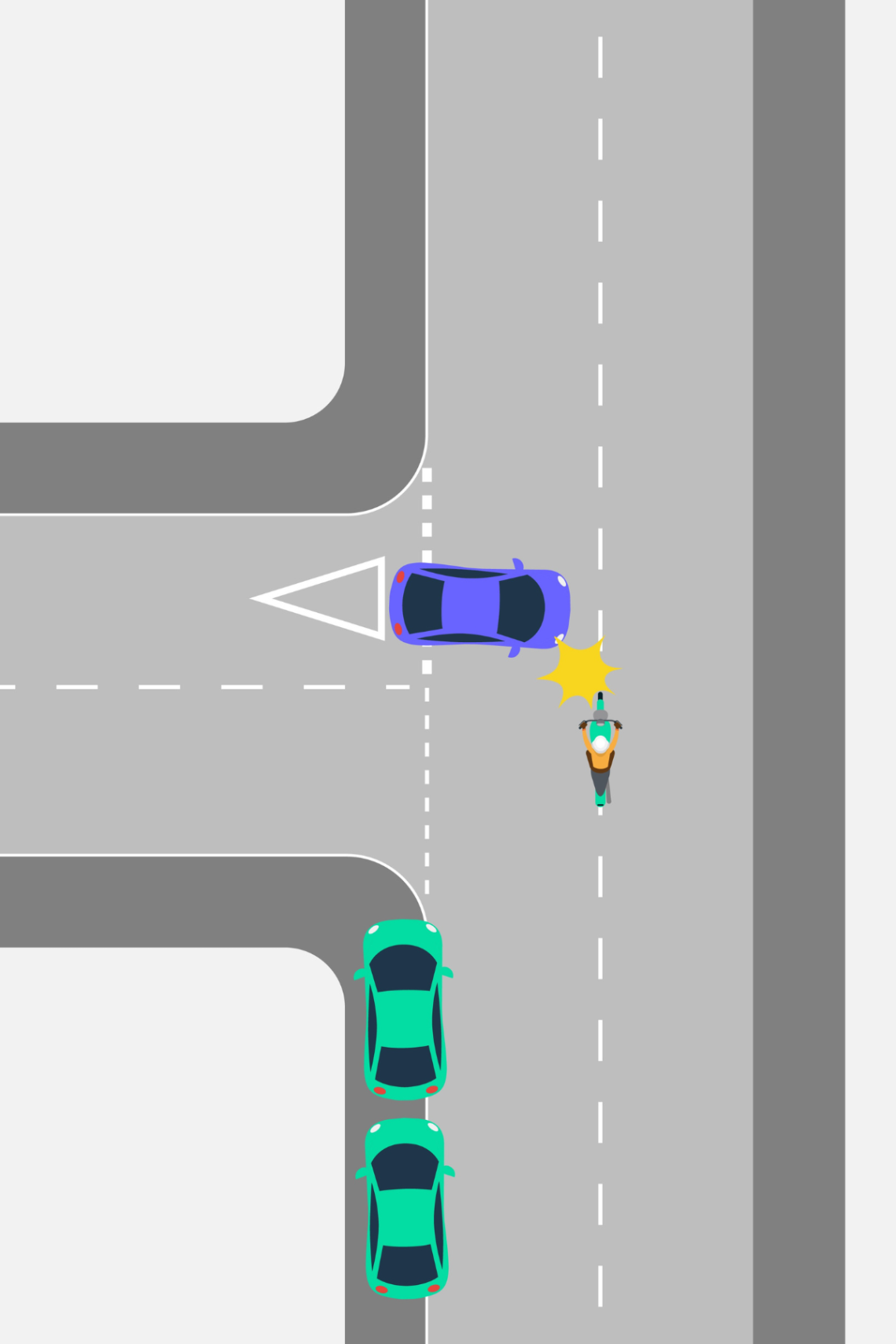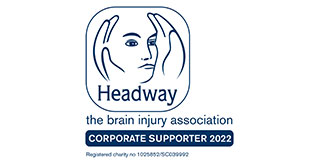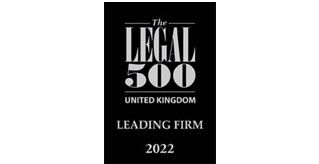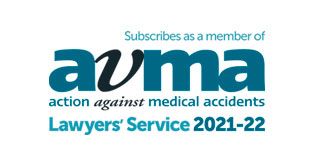Junctions
Where two or more roads meet at a junction, the chances of a motorcyclist being involved in an accident are greatly increased.
Why do most motorbike accidents happen at junctions?
There are many reasons why most motorcycle accidents happen at junctions but typical causes can include poor visibility for other road users due to obstructions or other vehicles, drivers not paying attention or not following the rules of the road (perhaps not using their indicators or mirrors correctly) and finally, poor vehicle control where the driver is not fully in control of their vehicle.
For a motorcyclist who wants to turn right onto a side road, they may need to indicate and stop near the centre of the road as they wait for a gap in the oncoming traffic. Motorcycle accidents can happen when a driver behind the biker fails to see them or is too impatient and attempts to squeeze past.
With vehicles stopping, pulling away, crossing lanes and turning into side roads, it’s hardly surprising that a large proportion of motorcycle accidents occur at junctions.
How do you avoid being involved in an accident by incorrect use of an indicator?
For bikers, the way to avoid being involved in this type of accident issue is by not making assumptions based purely on the use of other drivers' indicators. With experience, bikers may learn to wait until a vehicle has completed a manoeuvre or continued past the junction before pulling out or putting themselves in harm’s way. It’s also important to consider the other vehicle’s speed as this can help you work out whether they are due to turn.
For riders of bikes without automatic indicators, try to get into a habit of turning off your own indicators once you have completed every turn or slow-speed manoeuvre. This will help to inform others of your intended direction and reduce the likelihood of road users pulling out in front of you at junctions.
What’s the law on junctions?
The Highway Code recognises that bikers can be particularly vulnerable at junctions. Under their guidance on road junctions, they state that drivers should:
- Watch out for cyclists, motorcyclists and pedestrians, including powered wheelchairs/mobility scooter users, as they are not always easy to see. Be aware that they may not have seen or heard you if you are approaching from behind.
- Remain behind cyclists, horse riders, horse drawn vehicles and motorcyclists at junctions, even if they are waiting to turn and are positioned close to the kerb.
(The Highway Code Rule 170)
They go on to say that when turning right at a junction, drivers should “watch out for cyclists, motorcyclists, pedestrians and other road users. Check your mirrors and blind spot again to make sure you are not being overtaken, then make the turn. Do not cut the corner. Take great care when turning into a main road; you will need to watch for traffic in both directions and wait for a safe gap.”
(The Highway Code Rule 180)
They also advise (Rule 188) that if turning right at a crossroads, drivers should be aware that motorcyclists may be hidden from view.
The hierarchy of road users
An update to the Highway Code in January 2022 recognises that some road users are more vulnerable than others. The concept of the hierarchy of road users recognises that “those in charge of vehicles that can cause the greatest harm in the event of a collision bear the greatest responsibility to take care and reduce the danger they pose to others.”
Case Law on Junctions
Below is an example of case law involving motorbikes and junctions. It’s important to remember that every case is different and that the circumstances of a case are unique to that particular case.
Smith v Kempson (2011)
In December 2007, the driver, Mrs Smith was at a junction to join a major road from a minor road, but her view to the right (along Oak Hill) was obscured by parked cars and a parked van. Due to the position of these parked vehicles, any vehicle travelling along Oak Hill had to travel in the right-hand lane, on the wrong side of the road. Mr Kempson was travelling on his motorcycle towards the junction along the right-hand lane of Oak Hill, and as Mrs Smith emerged from the junction, the two collided.
Under cross-examination, it was confirmed that Mrs Smith would have been unable to see Mr Kempson before exiting the minor road or at any point until she emerged past the front of the van parked on Oak Hill.
The Judge decided that the blame lie solely with the driver and that on the balance of probabilities, the collision was caused by Mrs Smith’s negligence in pulling out on to a major road when it wasn’t safe to do so. It was concluded that the chances were 51% that the accident occurred as a result of Mrs Smith falling below the standard of a reasonable driver.
Being seen is something that is important as a motorcyclist. Try to wear a brightly coloured helmet or clothing with reflective materials to give you that added chance of being seen. This case was a good result; as always try to increase your awareness when overtaking parked cars where they obscure a junction.

How do solicitors fight a motorbike at a junction case?
In cases involving junctions, it might be argued that the driver was flashed by another vehicle, signalling that it was safe to go, or that the biker wasn’t seen by the driver until it was too late.
However, as demonstrated by Smith v Kempson, motorists have a duty of care to drive at a reasonable standard. And thanks to changes in The Highway Code introduced to protect vulnerable road users like bikers, there is now a greater responsibility on drivers when it comes to cases like these.
While there may be attempts to blame the biker, our team of experienced motorcycle accident solicitors will help counter this, putting together a more accurate representation of what happened. Your solicitor will work with a team of independent experts to ensure that we achieve the very best outcome and secure the compensation you’re entitled to.
Why Biker SOS?
By choosing Biker SOS you’re choosing to work with motorbike accident specialists. We’ve handled 1 in 6 motorbike claims in the last 5 years alone – making us the largest specialist provider in the country.
We’ve represented hundreds of bikers in cases like this, so you can be reassured that you’re in safe hands. Our expert team will fight your corner and get you the compensation you deserve, supporting you throughout your claim, as well as your rehabilitation and recovery.
No Win No Fee
We understand the devastating impact a motorcycle accident can have on your life and the financial pressures it can bring, so we handle your claim on a No Win No Fee basis, meaning you won’t pay anything upfront to start your claim.
We’ve secured millions of pounds for thousands of motorcyclists
Types of Motorbike Accidents
Undertaking
Are motorbikes allowed to undertake? Although generally discouraged, according to The Highway Code, motorcyclists are allowed to undertake other road…
Filtering
How could I avoid a filtering accident? Filtering is a legal manoeuvre and is relatively safe, as long as riders pay attention to keep their speed appropriate…
Bike/bus lanes
How to avoid a bus lane accident Buses stop and pull away regularly to allow passengers on and off. In order to avoid accidents, motorcyclists must plan…
Dropping the bike
Can I make a claim after a dropped motorbike accident? If another road user causes you to drop your bike and injures you, then there may be cause to…
U-turn from a car
How to avoid a U-turn accident On high-speed multilane roads or dual carriageways with turning areas, motorcyclists need to be extremely cautious where…
Potholes
Potholes can cause a motorbike rider to have what is known as a ‘tank slapper’, which is when the front end of the bike violently shakes from side to side,…
Road debris / spillages
Knowing that the road ahead is clear of obstructions and how much grip is available can determine the rider’s ability to stop, speed up or change direction…
Animals and Children
How does this type of accident happen? Motorbike accidents can happen when animals or children run into the path of a motorcyclist, causing the biker…
Hit and run
Drivers who flee the scene of an accident are often uninsured or aware that they were at fault. Being run-off the road by a driver who fails to stop, but…
Car door opened into path
How do car door motorcycle accidents happen? Often known as dooring, this type of motorcycle accident is unfortunately all too common. Either the biker…
Motorbike accident abroad
What happens if I have a motorbike accident abroad? With the promise of fantastic weather, stunning scenery and quiet roads, continental Europe has lots…
What to do in an accident?
How the claims process works.
You're in safe hands










